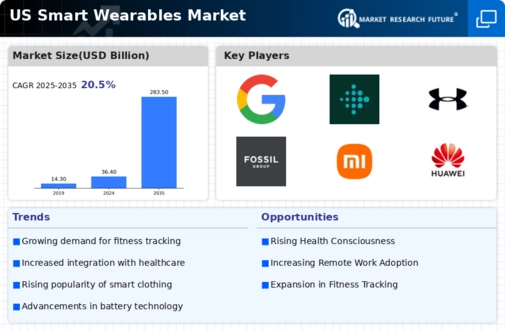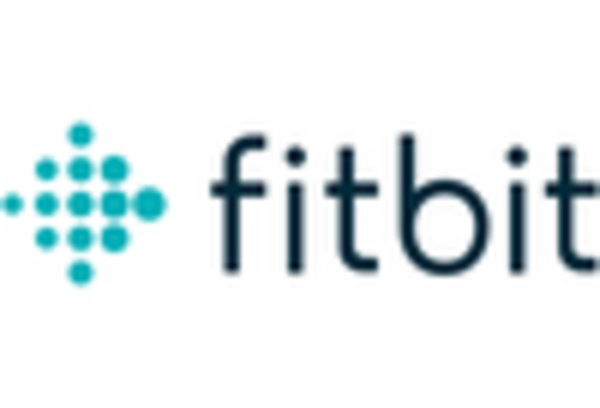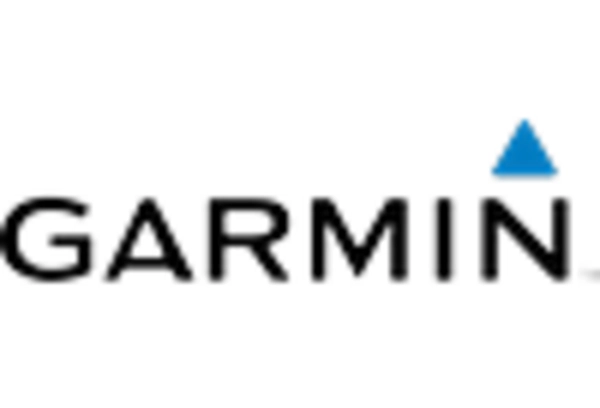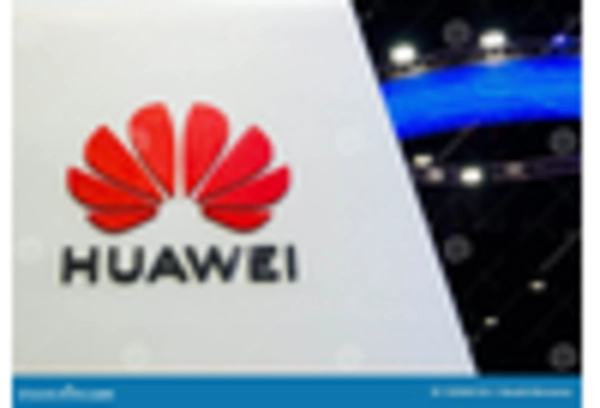The US Smart Wearables Market is currently characterized by a dynamic competitive landscape, driven by rapid technological advancements and evolving consumer preferences. Major players such as Apple Inc (US), Samsung Electronics (KR), and Garmin Ltd (US) are at the forefront, each adopting distinct strategies to enhance their market positioning. Apple Inc (US) continues to leverage its ecosystem of devices, focusing on seamless integration and user experience, while Samsung Electronics (KR) emphasizes innovation in health monitoring features. Garmin Ltd (US), on the other hand, targets niche markets such as fitness enthusiasts and outdoor adventurers, showcasing its commitment to specialized functionalities. Collectively, these strategies contribute to a competitive environment that is increasingly focused on differentiation through technology and user engagement.
In terms of business tactics, companies are increasingly localizing manufacturing and optimizing supply chains to enhance efficiency and responsiveness to market demands. The competitive structure of the market appears moderately fragmented, with several key players exerting influence over various segments. This fragmentation allows for a diverse range of products and innovations, fostering a competitive atmosphere where companies must continuously adapt to maintain their market share.
In August 2025, Apple Inc (US) announced the launch of its latest smartwatch model, which integrates advanced health tracking features, including blood glucose monitoring. This strategic move not only reinforces Apple's commitment to health and wellness but also positions it to capture a growing segment of health-conscious consumers. The introduction of such innovative features is likely to enhance customer loyalty and attract new users, thereby solidifying Apple's leadership in the smart wearables market.
In September 2025, Samsung Electronics (KR) unveiled a partnership with a leading fitness app developer to enhance its wearables' capabilities in personalized health coaching. This collaboration is indicative of Samsung's strategy to integrate software and hardware, providing users with a more holistic health management experience. By aligning with popular fitness platforms, Samsung aims to increase user engagement and expand its market reach, potentially leading to higher sales and brand loyalty.
In July 2025, Garmin Ltd (US) expanded its product line to include a new series of smartwatches specifically designed for outdoor activities, featuring enhanced GPS capabilities and rugged designs. This strategic expansion reflects Garmin's focus on catering to niche markets, particularly outdoor enthusiasts who prioritize durability and functionality. By diversifying its offerings, Garmin is likely to strengthen its competitive position and appeal to a broader audience.
As of October 2025, current trends in the US Smart Wearables Market indicate a strong emphasis on digitalization, sustainability, and the integration of artificial intelligence. Strategic alliances are increasingly shaping the competitive landscape, as companies seek to combine their strengths to innovate and enhance product offerings. Looking ahead, it appears that competitive differentiation will evolve from traditional price-based competition to a focus on innovation, technological advancements, and supply chain reliability. This shift suggests that companies that prioritize these aspects will likely emerge as leaders in the market.
















Leave a Comment